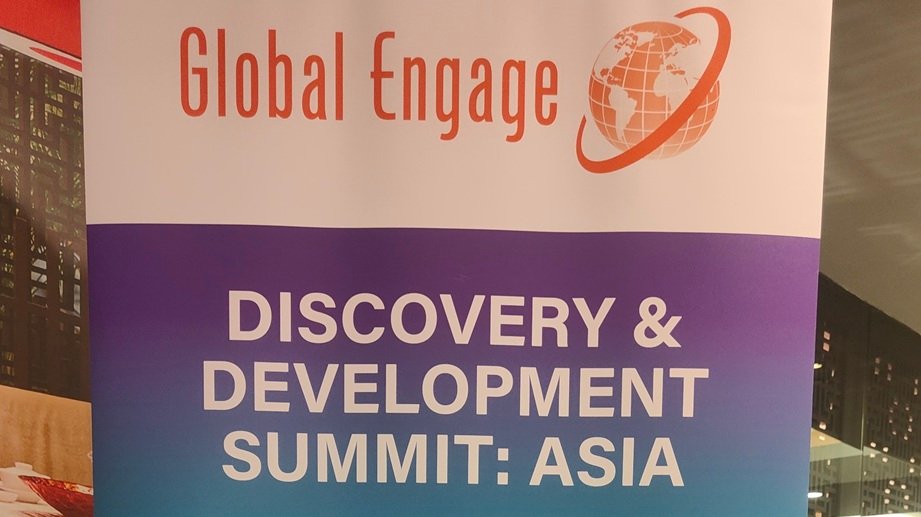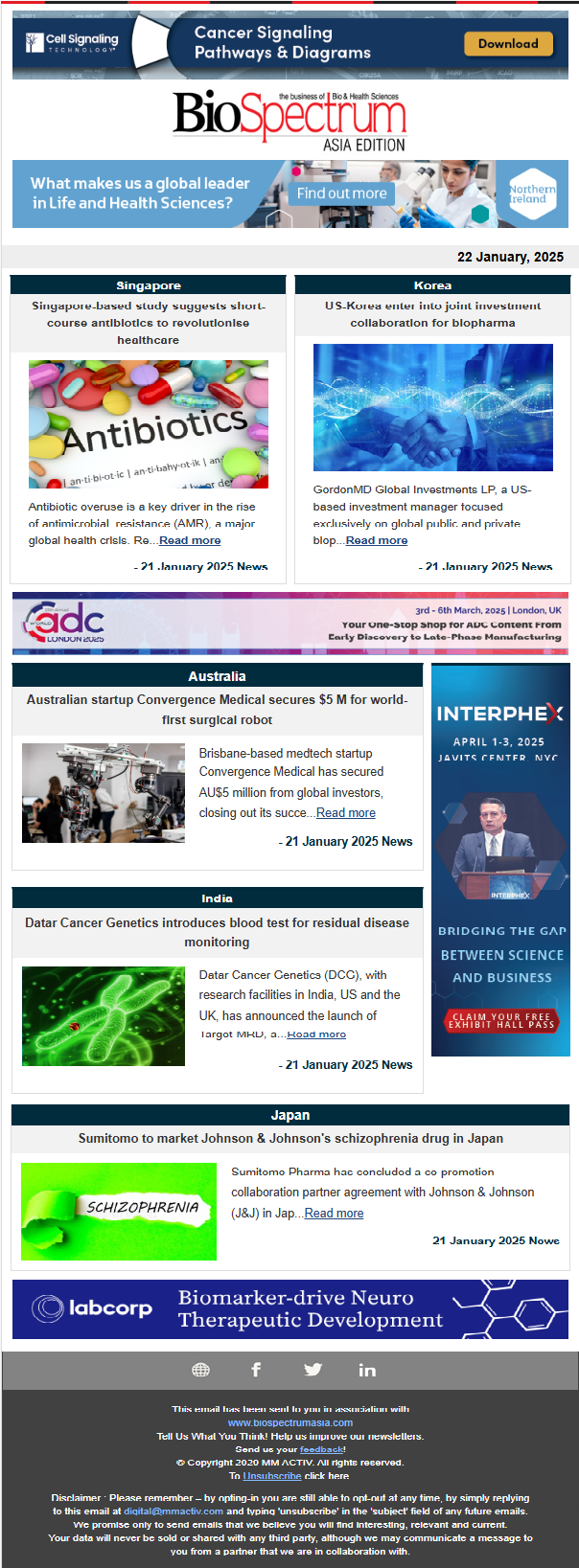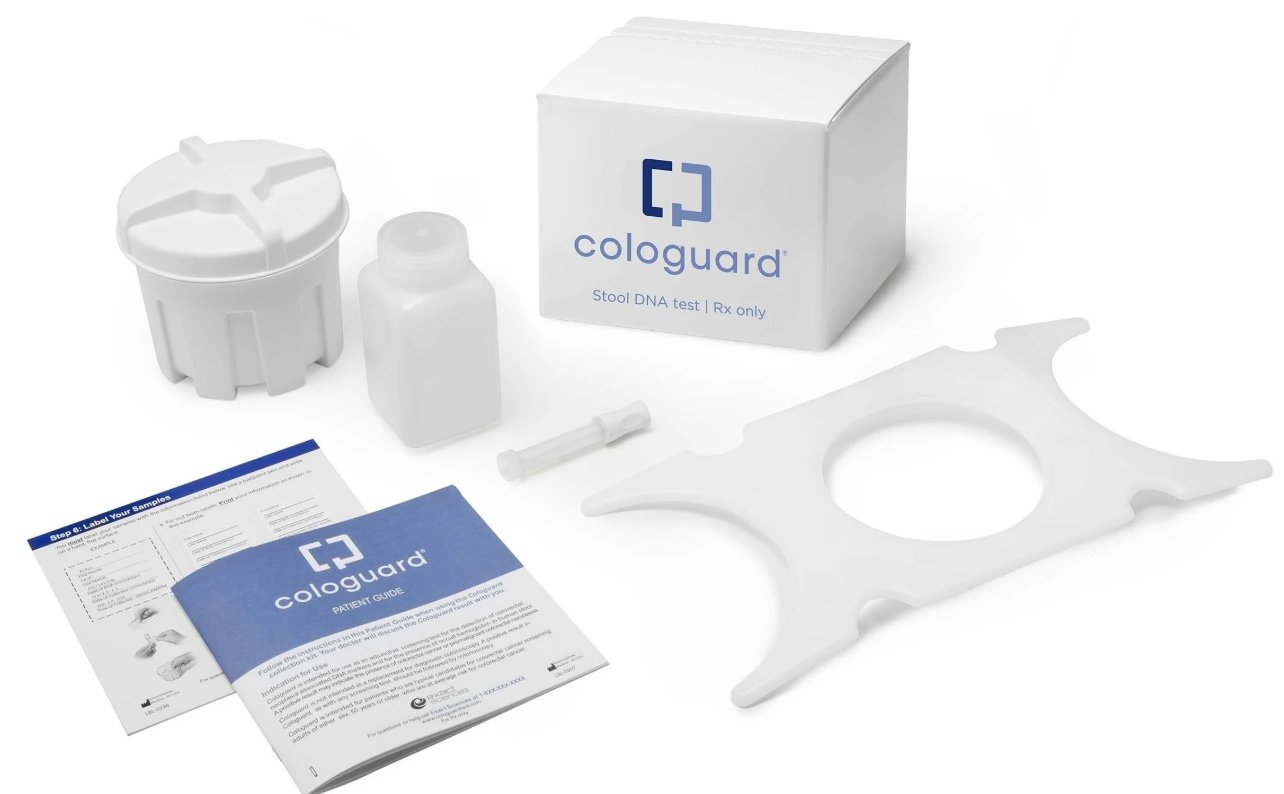
The Discovery & Development Summit Asia 2025, hosted in Singapore on September 9th and 10th, is set to be a landmark event in the life sciences sector. Bringing together leading experts, the summit aims to drive innovation in therapeutics amidst Asia’s rapidly expanding biotech ecosystem and growing R&D investments. With three concurrent congresses—Drug Discovery and Development Asia, Nucleic Acid Therapeutics Congress Asia, and Precision Medicine Congress Asia—the event offers a platform for academics, industry leaders, and regulatory experts to exchange ideas, explore cutting-edge advancements, and foster collaborations. Attendees can look forward to panel discussions, interactive workshops, and networking opportunities designed to bridge the gap between research and clinical application. Featuring globally renowned speakers and a dynamic agenda, the summit will address the complexities of modern drug R&D while shaping the future of healthcare innovation.
Global Engage hosted The Discovery & Development Summit Asia 2025, a groundbreaking event held in Singapore on September 9th and 10th. The summit capitalized on the dynamic growth of the life sciences sector, offering a premier platform for academics, industry leaders, and biotech innovators to share transformative ideas and advance next-generation therapies. It united global thought leaders and showcased revolutionary innovations in bioscience, driving progress in therapeutic development.
The two-day Discovery & Development Summit Asia 2025 fostered dynamic cross-sectoral dialogue, interactive sessions, and strategic networking to shape the future of drug discovery and development in Asia. Attendees explored the latest advancements in genomics, personalized medicine, and novel therapeutic modalities, underscoring Asia’s growing influence in the global biotech ecosystem. The event featured engaging panel discussions, fireside chats, flash talk sessions, interactive workshops, and extensive networking opportunities. It provided a collaborative platform for academics, industry leaders, biotechnology entrepreneurs, and regulatory experts to exchange transformative ideas and drive innovation in therapeutic development.
The summit brought together over 30 distinguished speakers, offered more than 7 hours of dedicated networking opportunities, and included poster presentations alongside an exhibition of advanced products and technologies, all focused on advancing therapeutic science and fostering innovation in the life sciences industry. It featured three co-located congresses, each dedicated to cutting-edge developments in modern therapeutics and precision medicine: Drug Discovery and Development Asia, Nucleic Acid Therapeutics Congress Asia, and Precision Medicine Congress Asia.
Drug Discovery & Development Congress Asia: First day of the conference explored the cutting-edge advances in drug R&D across the Asia-Pacific region, featuring topics such as AI-driven drug design, biomarker discovery, and disease modeling. Additionally, the conference focused on innovations in oncology, rare diseases, and neurodegenerative disorders.
Christopher BODENREIDER, Director of Experimental Drug Development Centre, Singapore, who leads early-stage research translation into clinical drug candidates, delivered the keynote address. In his address, Bodenreider shared insights on EDDC's role in advancing drug discovery through regional collaborations. He outlined EDDC's strategies for fostering partnerships that drive innovation, accelerate early-stage research, and support translational efforts. The presentation explored how leveraging regional strengths addresses therapeutic challenges and contributes to the growing biotech ecosystem.
Asad Abu Bakar, Director and Singapore Lead of Biomarker & Target Sciences (Imaging) at MSD, discussed advancements in biomarker development using AI/ML and big data. He highlighted the role of AI/ML in accelerating biomarker discovery and addressing critical gaps in research. By integrating medical biology, imaging, omics technologies, and big data analytics, he emphasized the potential for transformative impacts. The talk also explored how AI/ML can enable personalized medicine through patient sub-typing, early diagnosis, and improved treatment outcomes.
Huakang Tu, Director of the Center for Global Health at Zhejiang University, presented a study on improving microsatellite instability (MSI) detection in gastric cancer using histopathological slides. The research involved benchmarking pathology-specific foundation models using 222 whole-slide images from The Cancer Genome Atlas (TCGA). External validation on two independent cohorts showed superior diagnostic performance of pathology-optimized models compared to their natural image-pretrained counterparts. Multi-model fusion approaches further enhanced predictive capability, achieving high AUROC scores, and demonstrated the potential to democratize MSI screening and improve therapeutic stratification in gastric cancer.
Dinender Singla, Professor and Head of Metabolic and Cardiovascular Sciences at the University of Central Florida, presented research on the role of exosomes in mitigating cardiac and skeletal muscle dysfunction caused by doxorubicin (DOX) treatment. The study investigated how inflammation and inflammatory cytokines contribute to muscle dysfunction and adverse remodeling. Exosomes were shown to reduce inflammation by attenuating cytokine production and promoting anti-inflammatory cell types. The findings suggest that exosomes could serve as a next-generation therapeutic option to alleviate the side effects of DOX treatment.
Sioklay Monica Tan, Senior Director at Shinobi Therapeutics, Japan, discussed CMC regulatory challenges for Advanced Therapy Medicinal Products (ATMPs). She covered regulatory classification and the ATMP development landscape in the US, Japan, and the EU, focusing on CMC priorities in each region. She also highlighted opportunities for early regulatory engagement, including FDA INTERACT meetings, PMDA informal preconsultations, and EU Innovative Task Force interactions.
Amisha Shukla, Field Application Scientist at ThinkCyte, Japan, presented Ghost Cytometry, a breakthrough in single-cell analysis that uses AI-driven, label-free morphological profiling to analyze and sort cells without fluorescence staining. The technology captures real-time morphological features through light-scattering signals and processes them with machine learning. This innovation enables unbiased classification and sorting, advancing drug discovery, regenerative medicine, and immunology to redefine and accelerate discovery at scale.
Bryan Yeung, Vice President of Chemistry and Conjugation at Axcynsis Therapeutics, presented the discovery of AT2604, an antibody-drug conjugate (ADC) targeting ALPP/ALPPL2. These proteins, highly expressed in tumor cells but limited in normal tissues, make them ideal ADC targets. AT2604, conjugated with monomethyl auristatin E (MMAE), showed strong tumor growth inhibition at low doses in gastric and pancreatic cancer models. In patient-derived xenograft models, it achieved near-complete tumor regression at low doses. Preliminary toxicity assessments in non-human primates demonstrated a well-tolerated dose with good plasma stability, suggesting an improved safety profile compared to other vedotin-based ADCs.
Seung Jun Yoo, CEO of Medific Bio Inc., presented their work on targeting "undruggable" IDPs (intrinsically disordered proteins) to treat hard-to-treat diseases. IDPs, which lack a stable 3D structure, play key roles in cell signaling and gene regulation and are implicated in cancer and neurodegenerative diseases. Jun Yoo discussed strategies to develop novel drugs targeting IDPs, with their lead program in the preclinical stage for diseases like glioblastoma and hepatocellular carcinoma.
Nucleic Acid Therapeutics Congress Asia :The conference brought together leading experts in the field of RNA and DNA-based therapies, providing a comprehensive exploration of the latest advancements in discovery, delivery, and clinical translation, with a focus on innovative approaches to therapeutic development. Volker Patzel, Assistant Professor & Senior Lecturer at Singapore’s NUS presented the opening remarks.
Weihong TAN, who served as the Director of the Hangzhou Institute of Medicine (HIM) at the Chinese Academy of Sciences in China, specialized in analytical chemistry, chemical biology, DNA nanotechnology, and bioanalysis was one of the distinguished expert speakers. His work focused on advancing research in DNA aptamers, molecular recognition, and biosensors, contributing significantly to the development of innovative solutions in the biomedical arena.
The first session, presented by H.Fai Poon, CEO of the Hong Kong-based company Sirnaomics, focused on the siRNA delivery platform and its key applications. He highlighted the transformative potential of this technology in addressing unmet medical needs in oncology, metabolic disorders, and infectious diseases. Poon pointed out that tissue-specific siRNA therapies are effective in treating these conditions, and that peptide nanoparticles remain promising as a therapeutic approach.
Weihong TAN, Director of the Hangzhou Institute of Medicine (HIM) at the Chinese Academy of Sciences, delivered a keynote presentation on the use of aptamers—single-stranded DNA or RNA molecules—as molecular probes for disease detection and treatment. He highlighted that in molecular medicine, aptamers have been used in tumor detection, molecular imaging, targeted drug delivery, biomarker discovery, and disease subtyping since they selectively bind to proteins and small molecules. Additionally, findings from clinical trials were presented, highlighting the potential of aptamers to advance molecular medicine.
Hidetoshi TAHARA, CEO of PURMX Therapeutics in Japan, presented the therapeutic potential of microRNA-3140-3p, referred to as the "Aging Switch," in cancer therapy. He elaborated on a novel microRNA that induces senescence signals in cancer cells is being developed in the United States, Australia, and Japan with the purpose of treating malignant pleural mesothelioma and head and neck cancer. Additionally, he outlined the technological advancements in the treatment of solid tumors, demonstrating how innovative nucleic acid medicines can revolutionize the treatment of cancer.
Edward WONG, Senior Manager of Gene Writing & Editing APAC at Integrated DNA Technologies (IDT), presented on enhancing CRISPR safety through IDT's RhAmpSeq system for off-target evaluation, a system that provides a comprehensive workflow for off-target characterization, a critical step in advancing CRISPR-based therapeutic programs. Furthermore, he discussed proprietary statistical models and analytical tools that are capable of enabling precise detection thresholds and variant-level interpretations for end-to-end, data-driven workflows that allow therapeutic developers to evaluate genome editing safety, streamline regulatory documentation, and proceed confidently toward clinical applications.
Sherman ONG, SEA Product Manager for Automation and Genomics at Beckman Coulter Life Science, focused on accelerating drug discovery and development by utilizing innovative technology through integrated solutions that support researchers at every stage of the drug development process, including high-throughput automation, advanced flow cytometry, centrifugation, particle characterization, and microbioreactors. By simplifying workflows, improving data reliability, facilitating rapid decision making, and ensuring regulatory compliance, researchers can reduce time-to-market and provide life-changing therapies to patients faster, redefining what is possible in the pursuit of innovative medicines.
Krishna GANESH, Professor & Director at the Indian Institutes of Science Education and Research (IISER), India, presented on the development of "Janus PNAs" (Peptide Nucleic Acids) with the potential to silence two genes simultaneously. PNAs are DNA analogues with nucleobases linked to a pseudopeptide backbone, showing high-affinity, sequence-specific binding to complementary DNA and RNA. Janus PNAs carry two nucleobases in each monomer, enabling them to bind two different DNA/RNA sequences concurrently. These PNAs can form programmable assemblies, including double duplexes, triplexes, and tetraduplexes, with complementary DNA and RNA, leading to polyplexes. The formation of multiple duplexes on a single backbone enhances the thermal stability of each duplex, offering new opportunities for multiple gene silencing and material applications.
Tomasso TABAGLIO, Senior Scientist at the Institute of Molecular and Cell Biology (A*STAR) in Singapore, explored the design of antisense oligonucleotides (ASOs) for research and therapy, focusing on the role of artificial intelligence (AI). As ASOs become increasingly effective in treating rare genetic diseases, there is a growing need for rapid and personalized therapeutic strategies. While AI shows promise in revolutionizing ASO development, its effectiveness varies. Through his discussion, Tabaglio evaluated AI-driven approaches alongside traditional computational and experimental methods, emphasizing areas where AI excels, such as splice-switching oligo design, but also areas requiring human expertise. AI is not a silver bullet, but it can be a powerful tool when integrated wisely into personalized medicine.
Volker PATZEL, Assistant Professor and Senior Lecturer at the National University of Singapore, presented the development of SPRING DNA, a minimalistic, non-viral, dumbbell-shaped DNA vector for gene therapy, mitochondrial gene therapy, and genetic vaccination. SPRING DNA is produced via a scalable, cell- and bacteria-free enzymatic process and can be delivered naked, via lipid nanoparticles (LNPs), or as conjugates. It uses RNA trans-splicing for cell-targeted expression and a novel RNA-based vector for mitochondrial delivery when needed. SPRING DNA is stable without requiring a cold chain, has no cargo size limit, is immune-quiet, redosable, and efficiently enters the cell's nucleus. According to Patzel, SPRING DNA overcomes existing vector limitations and shows promise for gene therapy and genetic vaccination.
Jin Rong OW, a Senior Scientist at the Institute of Molecular and Cell Biology, A*STAR, Singapore, presented an integrated diagnostic and therapeutic platform for addressing Urea Cycle Disorder (UCD). UCD is a group of autosomal recessive genetic diseases characterized by defects in the urea cycle, leading to elevated blood ammonia levels that can be fatal. She presented an in-depth discussion of developing splice-switching oligonucleotides for the treatment of Urea Cycle Disorder using an integrated diagnostic and therapeutic approach.
A panel, titled "Viability, Accessibility & Sustainability: Advancing Nucleic Acid Therapeutics from Research to Clinic," explored strategies for transitioning nucleic acid therapeutics from research to clinical application while ensuring that they are viable, accessible, and sustainable. Prime aspects were: Designing therapeutics with scalability in mind from early research stages; Addressing delivery, stability, and toxicology challenges during clinical development; Aligning academic innovation with industry feasibility to streamline priorities; and fostering long-term partnerships between academia and industry to accelerate therapeutic pipelines. Moderated by Wonil Kim (Aston Sci. Inc.), the panel featured experts from Sirnaomics (Hong Kong), Murdoch University (Australia), and A*STAR (Singapore), who shared insights on overcoming translational challenges and advancing patient access through collaboration and innovation.
Edwin Simjaya, Head of Artificial Intelligence & Software Center at PT Kalbe Farma, Indonesia, presented on how AI is transforming pharmaceutical R&D by accelerating drug discovery, improving predictive modeling, and optimizing decision-making. He highlighted the concept of AI integration across the drug development pipeline, from target identification to preclinical optimization, using machine learning and multi-omics data. Case studies demonstrated the success and challenges of deploying AI in real-world pharmaceutical environments across Southeast Asia.
Precision Medicine Congress Asia:
On the second day of the event, breakthroughs in personalized healthcare were explored through genomic science, targeted therapies, and patient-centered approaches. With case studies on cancer and rare diseases in the region, the sessions offered practical insights into pressing healthcare challenges in the region. It highlighted advances in personalized treatments based on genetics, environment, and lifestyle factors.
Minh Le, Assistant Professor at the National University of Singapore, presented the development of bispecific extracellular vesicles (BEVs) for cancer immunotherapy. BEVs, derived from human red blood cells, are functionalized with antibodies targeting CD3 on T cells and tumor antigens, enabling localized immune activation. They demonstrated enhanced T cell activation and stronger responses compared to free antibodies, with reduced toxicity risk. BEVs targeting PD-L1 or Claudin-18.2 proteins reduced tumor burden and prolonged survival in mouse models of lung and pancreatic cancer. Systemic administration in nonhuman primates showed a favorable safety profile, establishing BEVs as a scalable, versatile platform for clinical translation.
Chee Yang Lee, Senior Field Application Scientist at Agilent Technologies, introduced Avida's target enrichment technology for liquid biopsy and multiomic analysis. Overcoming the challenges of detecting cancer-associated genomic alterations from circulating cell-free DNA (cfDNA) by offering high-sensitivity variant detection and simultaneous methylation analysis from low-input samples. This integrated approach enhances tumor biology understanding and accelerates biomarker discovery in precision oncology.
Gautham Sethi, an Associate Professor at the National University of Singapore, presented strategies to inhibit oncogenic transcription factors and signaling pathways for cancer treatment. He highlighted STAT3, a key transcription factor frequently hyperactivated in various cancers, driving tumor progression, metastasis, and drug resistance. Additionally, the c-Met/HGF pathway was identified as a synergistic pathway enhancing angiogenesis and invasive growth.
Andiappan Murugan, Senior Vice President of R&D at Troikaa Pharmaceuticals, discussed the complex process of selecting candidates for pre-clinical and clinical studies. He emphasized the need for thorough evaluation to ensure compounds are both effective and safe. Collaborative and science-driven approaches were highlighted as essential to successful drug development.
Jasmin Major, Senior Programme Manager at Challenge Works, presented the Longitude Prize for ALS, an international initiative to encourage AI-based approaches to drug discovery for Amyotrophic Lateral Sclerosis (ALS). The prize, supported by multiple global organizations, aims to transform treatment development for this common motor neuron disease. It collaborates with leading data and technology partners to advance research.
Gergely Toth, CEO and Founder of Cantabio Pharmaceuticals, discussed the development of pharmacological chaperones targeted at the misfolding and aggregation of proteins linked to Parkinson's disease. These small molecules were designed to stabilize the native monomeric state of these intrinsically disordered proteins (IDPs) and inhibit their aggregation. The results demonstrated the feasibility of this approach for reducing misfolding and preventing the formation of toxic oligomers.
Jagadish Sankaran, a Senior Scientist at the Genome Institute of Singapore, A*STAR, discussed a Singapore-developed method to integrate morphology and gene expression data in spatial omics analysis. This approach addresses the gap in current algorithms that focus on gene expression and location but neglect morphology. Sankaran describes the method as a game changer enabling the discovery of novel morphogenomic phenotypes from cellular-resolution spatial omics datasets with imaging components.
Kyeong Kyu Kim, a Professor at Sungkyunkwan University, South Korea, discussed the development of a novel approach to induce brown adipocyte reprogramming using a combination of small molecules (SB431542 and NKH477). This method enhanced browning in mouse embryonic fibroblasts and protected high-fat diet-fed mice from glucose metabolism impairments when administered intraperitoneally. Additionally, microneedle patches embedded with the molecule cocktail demonstrated local browning effects on subcutaneous white adipose tissue.
Ser Mien Chia, a Principal Scientist at MSD in Singapore, discussed the transformative role of biomarkers and translational research in advancing precision medicine. The presentation highlighted how multi-omics platforms, biomarker assays, and AI-driven analytics enhance drug development by enabling critical go/no-go decisions and identifying novel therapeutic targets. Strategic collaborations with academic and clinical partners were emphasized, alongside the importance of equitable access to precision medicine across Asia.
Hyun-Young PARK, Director General of the National Institute of Health in South Korea, presented on the country's efforts in genomics, epidemiology, and health data integration, highlighting the advancements and strategies driving personalized healthcare and addressing pressing healthcare challenges in the APAC region.
The summit bridged the gap between research and application, offering practical insights that accelerate the journey from bench to bedside and shaping the future of healthcare innovation.
A wide range of innovative tools, technologies, and services were showcased to attendees who sought to enhance their research capabilities. Expert panels and keynotes led by industry thought leaders provided valuable insights as well. During this program, participants were able to interact with the top executives and decision makers from the leading pharmaceutical and biotech companies, collaborate with pioneering scientists and researchers, and gain regulatory perspectives on compliance and market access strategies from industry experts.




